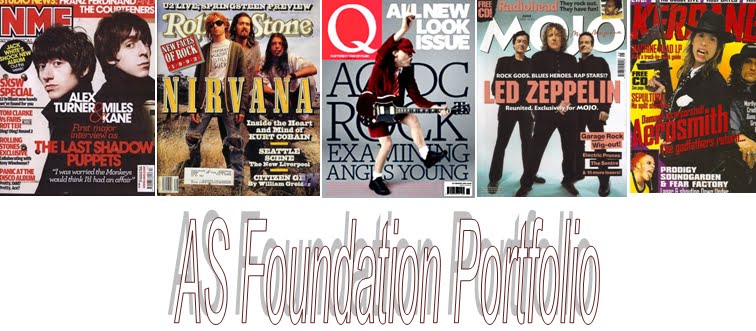 Q Magazine opt for a more simplistic graphology, using one main image of the star/band used on the front cover. The image does not rely upon his sex appeal but rather his reputation as a musician. Q is a monthly edition therefore the banners make this known to the reader - 'Every Month'.
Q Magazine opt for a more simplistic graphology, using one main image of the star/band used on the front cover. The image does not rely upon his sex appeal but rather his reputation as a musician. Q is a monthly edition therefore the banners make this known to the reader - 'Every Month'. The banners use coordinating colours so as to represent the clean cut nature of Q magazine, which wants substance over style.
Quotes from band members are used in order to advertise whats to come in the rest of the issue and to generate interest in the rest of the article 'I fart in your face'.
Q magazine is popular for formulating lists of best Beatles songs, '100 greatest albums ever' etc. This is a special promotional method which entice consumers.
The information is presented neatly and is organised with the text of Sans Serif font on the left hand side, and the main image to the right.
There are no promotional offers, as the target audience of Q magazine only buy the magazine for the purpose of music.



 e all neatly aligned as to fit in with the iconography of Q magazine - due to the target audience being mainly older music lovers. The numbers are neatly kept in the same colour scheme, in a bold font to show the numeric order and allow coherency. Red, white and black are the colours of font used throughout this edition, this creates a systematic style and looks easy on the eyes. The double page spread is set out as a compiled list - numbered with the most interesting facts highlighted, many images are used also - but these are spread out around the text to create cohesion.
e all neatly aligned as to fit in with the iconography of Q magazine - due to the target audience being mainly older music lovers. The numbers are neatly kept in the same colour scheme, in a bold font to show the numeric order and allow coherency. Red, white and black are the colours of font used throughout this edition, this creates a systematic style and looks easy on the eyes. The double page spread is set out as a compiled list - numbered with the most interesting facts highlighted, many images are used also - but these are spread out around the text to create cohesion.









